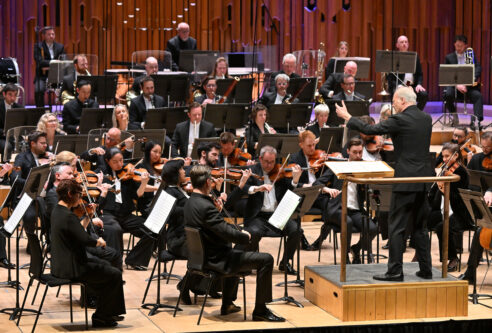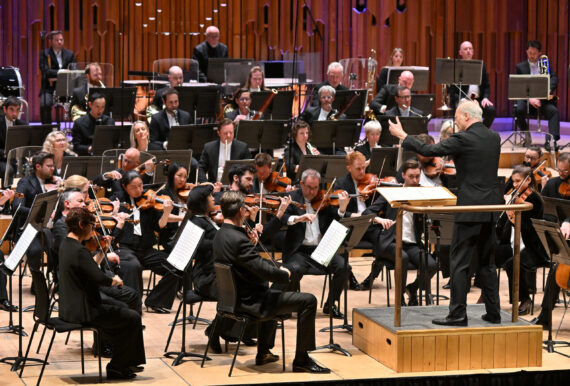 United Kingdom Schubert, Beethoven, Prokofiev: Pierre-Laurent Aimard (piano), London Symphony Orchestra / Gianandrea Noseda (conductor). Barbican Hall, 10.4.2025. (CC)
United Kingdom Schubert, Beethoven, Prokofiev: Pierre-Laurent Aimard (piano), London Symphony Orchestra / Gianandrea Noseda (conductor). Barbican Hall, 10.4.2025. (CC)

Schubert – Die Zauberharfe Overture, D 644, ‘Rosamunde’(1820)
Beethoven – Piano Concerto No.1 in C major, Op.15 (1795, rev. 1801)
Prokofiev – Symphony No.2 in D minor, Op.40 (1924/25)
It is a long way, musically, from Schubert and Beethoven to Prokofiev’s often cacophonous Second Symphony. I wonder if, as well as paying tribute to a great, much-missed composer, pianist Pierre-Laurent Aimard was creating something of a bridge in encoring four of Pierre Boulez’s Notations after the concerto? It was an inspired idea, anyway, and few pianists play Boulez with such authority, understanding, and – yes – emotion, than Aimard.
But the concert began way back with Schubert, what used to be known as Rosamunde Overture and is now Die Zauberharfe, a three-act melodrama premiered in Venna in 1820. For a long time, the Overture was attributed to Rosamunde’s incidental music (the Zauberharfe Overture was later published alongside the Rosamunde incidental music, hence the confusion). The Overture is one of contrasts, and I know few conductors who draw the contrasts so vividly as Gianandrea Noseda (he made me think of the Furtwängler January 1951 Vienna account in this regard). Noseda, too, relished Schubert’s cheeky false ending and, once the gravitas of the opening was established – silken strings – he allowed the sun to come out, especially thanks to Chris Richards – who was to feature so strongly in the Beethoven – offering a wonderfully characterful clarinet solo. There was a slightly raw edge to the London Symphony Orchestra’s upper strings in the Allegro, but this made for a bracing start to the concert.
Pierre-Laurent Aimard has of course recorded the Beethoven Piano Concertos Nos. 1-5 with the Chamber Orchestra of Europe and Nikolaus Harnoncourt. Interestingly, both Harnoncourt and Noseda offer an orchestral exposition to the first movement that feels low voltage. Although first in numbering and the second in order of composition, this concerto remains early Beethoven (and in a major key) and needs a spring in its step. Aimard does offer a complete rethink, however, evident right from the off (two distinct statements at the piano’s first entrance. Aimard’s Beethoven is clean, for sure, but can also verge on the literal (the right-hand scalic descents). All credit to Noseda for a spirited approach to the cadenza (the long third of the three Beethoven himself provided). A nice idea to have big pauses after each of the piano’s last two chords, but if the idea was wit, it did rather fall flat.
The Largo began with a somewhat literal piano statement from Aimard before Chris Richards’s molten legato and stunning tone righted matters. It did rather feel like Aimard could not settle completely in this movement; a return to the principal theme did rather begin with an awkward thump; it was, however, rescued by Richards’s contributions on clarinet. The Rondo finale was sprightly, with the cross-hand treble/bass dialogues in the piano successful, and the returns back to the main theme carefully considered. It was the Boulez encores that transfixed, however, a set of four carefully chosen, contrasting micro-statements of exquisite beauty.
Prokofiev’s Second Symphony is rarely heard, and for good reason. The first movement is a screaming behemoth. Trumpet players are often challenged; here they had a ball, led by the superb James Fountain. Noseda found the way through the sheer mass of sound by identifying Prokofiev’s layering; the ear was naturally led to Prokofiev’s processes. This was the obverse of the Beethoven: ultra-colourful, with Prokofiev’s zaniness unashamedly foregrounded. Discipline was evident from each and every orchestral department. Prokofiev’s imagination never flags for a second. A chant-like theme against pizzicato strings is remarkable and was mightily effective: it is clear Noseda’s comprehensive knowledge of the score; its scoring and its structure is almost beyond peer (I did enjoy Vladimir Jurowski’s recording of this piece, though). Few performances have made more of the awesome percussion towards the end of the movement, though.
And so to the second movement, a Theme and Variations (Prokofiev did say the piece was based on Beethoven’s Piano Sonata in C minor, Op.111). The theme is a kind of ‘disturbed tranquility’; the oboe sings (and, with Oliver Stankiewicz, it certainly did). How beautiful the shadowy murmurings of Variation I, how clear Prokofiev’s thematic workings in Noseda’s reading. The filigree available was extraordinary, too in contrast to decidedly more martial moments of Variation II. If the third variation seems to imply the Prokofiev of the ballet, the fourth contained an unutterably haunting beauty with hints of a restrained, clockwork mechanism at work. The double bass/bassoon opening of the final variation cut deep, a chant-like theme above. Here, at the end, was Noseda’s structural awareness in microcosm, the section moving perfectly to a brass and percussion pummeling, high violins screaming in protest. And, as in Beethoven Op.111, the return of the theme comes as a revelation, the music itself the same but transfigured in the light of previous lived experience.
This was a truly momentous performance.
Colin Clarke
